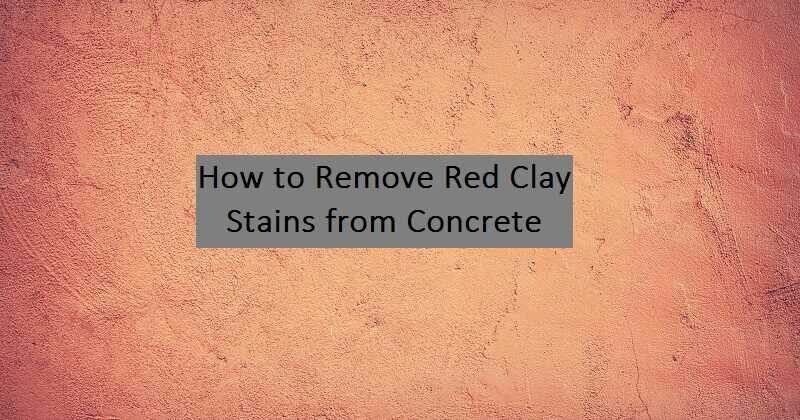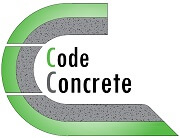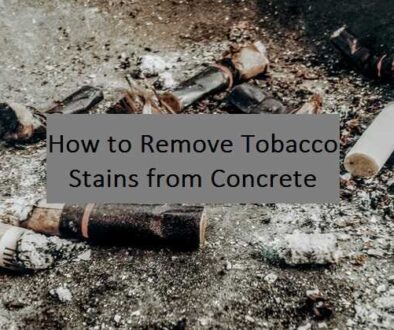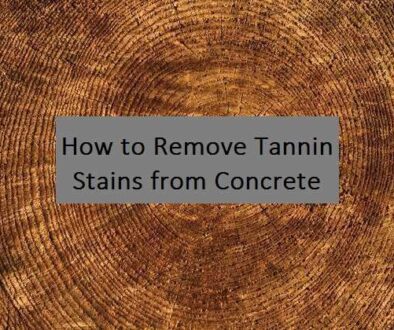How to Remove Red Clay Stains from Concrete

Last updated on April 7th, 2023
Exterior bare concrete surfaces can be subject to various stains, including those from soil. In fact, clay stains are quite common, especially in areas where red clayey soil is present, such as southern United States, South-Eastern States, and other regions in Africa, Asia, Australia, and South America. Often, home owners in these areas wonder how to remove red clay stains from concrete on their porches, sidewalks, walkways, driveways, walls, and masonry. Fortunately, there are different methods, and their effectiveness depends on the toughness of the stain.
However, the toughness of clay stains can vary, depending on the chemical composition of the soil, porosity of concrete, and age of the stain. Sometimes, the removal method is quite simple, especially for new stains. However, old soil stains, especially red clay ones, can sometimes be tough and require different methods.
In this article, we will present the best methods for the removal of clay stains from concrete, starting from the easy and mild methods to the harder and harsher ones. Besides, it is important to note that stubborn red clay stains may require other methods, which we will also provide, due to their composition as we will explain in the next section. However, it is always best to start mild, and increase the harshness gradually.
The chemistry behind red clay stains on concrete
In general, clay mainly contains silica, in addition to a combination of minerals. And, with its continuous exposure to weathering, some minerals leach out, which increase the concentration of the other stable minerals. These stable minerals mainly include aluminum and iron oxides.

Red clay soil, or Ultisol, is a type of soil characterized by its reddish brown color, and mostly found in humid tropical regions. It can be considered as a highly “weathered” type of soil, in which some of its minerals leached out, including calcium, potassium, and magnesium, and increased its concentration in aluminum and iron oxides. In fact, iron oxide is the mineral responsible for its reddish brown color.
Accordingly, such stains on concrete are in fact iron oxide, or basically “rust”. Thereby, usually the most effective methods on how to remove red clay stains from concrete, especially old and stubborn stains, are the same methods as for rust removal. However, in this article, we will present the relatively mild and easy methods which are effective for most clay soil stains and for relatively new red clay stains. Otherwise, for old and stubborn red clay stains, refer to our article on the removal of rust stains.
But how do these minerals stain concrete?
Clay consists of very fine particles, generally less than 2 micrometers. In addition, iron oxide, as the mineral of concern in red clay soils, is insoluble in water. Consequently, these fine particles can penetrate into the surface of concrete to fill the voids, thus creating the stain. In fact, red clay soil can be carried to the concrete surface during heavy rain, splashes, or even simply by footwear.
How to remove red clay soils from concrete: The best proven methods
Just like many other stains, there are several methods which can help in reducing or removing the clay stains. However, we will present the most effectiveness and proven methods.
Method #1: The easy DIY method for the removal of new soil stains

The first method is relatively simple, and is not harsh on the surface. Basically, it is effective for relatively new soil stains.
Things you will need
- Stiff bristle brush.
- Warm water.
- Soap.
- Clean water.
- Low pressure washer – optional.
Steps
- Rinse and flush the surface with warm water.
- Scrub the surface with warm water and soap (about 1:20 ratio) using a stiff bristle brush.
- Rinse the surface thoroughly with clean water, or use a low pressure washer.
- Repeat if minor staining remains.
Explanation
In this method, you start first by rinsing and flushing the surface with warm water. The reason for this step is to slightly increase the temperature of the surface and remove any debris and dirt, preparing it for the next steps. Then, scrub the surface with warm water and soap using a stiff bristle brush. For every 1 part of liquid soap, use 20 parts of water. If the surface is large, you can divide it into several areas to work efficiently while keeping the water warm before scrubbing. Any finally, rinse and flush the surface with clean water, or using a low pressure washer if available. After rinsing, repeat the process if you find any spots that you missed or still have minor staining.
Method #2: The simple yet effect method to remove relatively “stubborn” soil stains from concrete

This method is also relatively easy, and is more suitable for stubborn soil stains. It mainly involves the use of a bleaching agent, which is the effective compound in this method.
Things you will need
- Water.
- Safety gear.
- Chlorine bleach.
- Stiff bristle brush.
Notes
- Chlorine bleach is a liquid that consists of sodium hypochlorite, water, and other chemicals.
Appearance: Colorless or slightly yellowish liquid.
Availability: It is available at supermarkets.
Hazards: This compound is corrosive to flesh, and can react with other chemicals to produce a toxic gas.
Steps
- Wet and flush the surface.
- Wear your safety gear.
- Apply chlorine bleach to the wet surface.
- Use a stiff bristle brush to scrub the surface.
- Rinse the surface thoroughly with clean water.
Explanation
This methods starts first by wetting and flushing the surface to remove any loose dirt and debris, and saturating the concrete with water. Then, you should put on your protective gear, and apply the chlorine bleach to the wet surface. Afterwards, scrub vigorously using a stiff bristle brush. And finally, rinse and flush the surface with clean water.
Method #3: The use of special concrete cleaning products
This is a relatively easy method and is generally highly effective especially when selecting the right product.
Things you will need
- Follow the manufacturer’s instructions.
How to remove red clay stains from concrete: Old and more stubborn stains
For old and more stubborn red clay stains, these methods might not be highly effective. Instead, you should use the same methods as for the removal of rust stains, which include the use of acids or special agents.
Frequently asked questions
Will bleach, CLR, or TSP remove red clay stains from concrete?
These compounds can be effective on relatively stubborn soil and red clay stains. However, for older and more stubborn stains, acidic compounds should be used, similar to the ones effective for the removal of rust stains.
Can power washing clean old red clay stains?
Iron oxide is highly insoluble in water. Thereby, any method which does not include a compound which iron oxide is soluble in, is basically not very effective on old and stubborn stains. In addition, power washing may work great right on the surface due to its pressure, but won’t be as effective on the pigments inside the pores. Moreover, excessively high pressure can actually damage the surface before removing the deep red clay pigment.
Final thoughts
The methods presented in this article are suitable for most soil stains and relatively new red clay stains. However, one of the best practices is to remove as soon as possible, or even better, take preventive measures. These include avoiding the contact of red clay or red-clay-contaminated water with the concrete, or applying a sealer.




